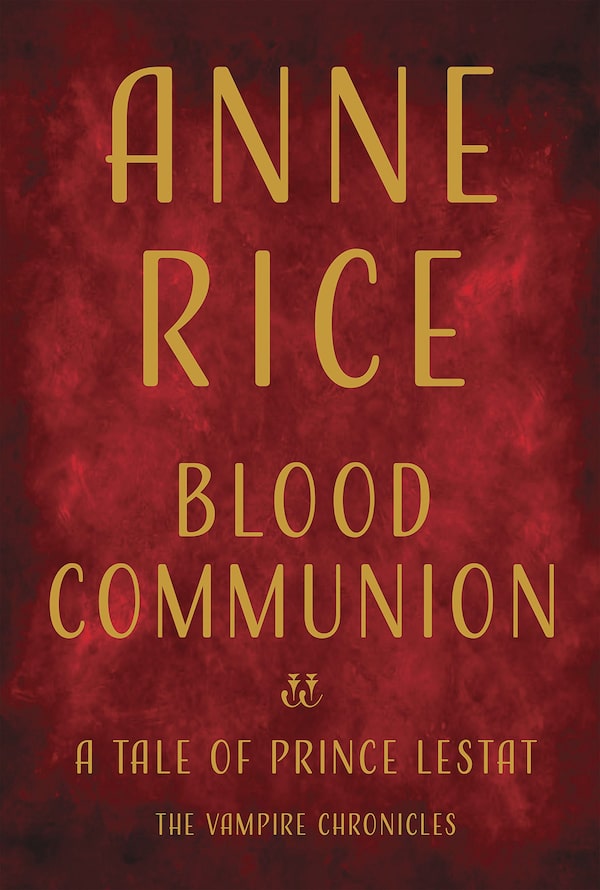At a key moment of Blood Communion, the new Anne Rice novel, the world’s vampires gather for a ball. The vampire Lestat presides. He dances with a diverse cast of female vampires, then retreats, to gaze upon the action.
Only then does Lestat see what he most wants. Or, rather, who: the sensitive, poetic vampire Louis. Lestat claims his prize. They dance with joy, shattering the ball’s heteronormativity – “making one body.”
This public coming-out comes as no surprise to long-time Rice readers. Rice’s books have long been queer. But the moment is still bracing. In evoking the peaceful union of the world’s vampires, Blood Communion (which is also the unofficial name of this secular-spiritual gathering) makes a powerful statement about morality. What we need, Rice tells us, is non-judgmental love. Or, as Lestat says with Louis in his arms, “One can dance a thousand ways.”

It is auspicious that Blood Communion is the 14th in Rice’s Vampire Chronicles. Across many cultures, the number 13 is linked to dark magic. Folklorists speculate that the reason is in the stars. There are 12.41 lunar cycles in a year. But many of the ancients looked for neat fits. The moon-time in excess of 12 seemed weird. Thirteen became a sign of fearful asymmetry, of lunar rebellion against the sun. Blood Communion marks the completion of an uncanny turn – from the aching loneliness of Rice’s early stories, to a radical politics of inclusion.
The vampire Lestat is the hero of Blood Communion. Readers first met him in 1976, with Rice’s first book Interview With The Vampire. Lestat was the villain of that piece. He turned Louis – Interview’s narrator – into a blood-drinker. Louis had mixed feelings. But, ultimately, he consented. Louis and Lestat raise a tortured vampire girl, Claudia, in the decadence of 18th-century New Orleans. Then things get dark.
In Blood Communion, Lestat rules over the global vampire community, who elected him prince. Lestat and Louis are reconciled. (Claudia is long gone, having turned to ashes in the sun, but is pictured at the vampire castle in a mural.) A rebel blood-drinker who hates Lestat’s government kidnaps Louis. Lestat must both learn to lead and save his love. His adventure makes for a gripping page-turner, at once delightful to old fans and accessible to the castle’s newcomers.
It is gorgeously written. The book shows Rice is still the greatest modern writer of supernatural fiction. To her credit, Rice has not given up on the Bible-infused style of High Victorian Gothic that has long made her novels popular. “Hail a new revelation,” the vampire Gundesanth says in Blood Communion, of Lestat’s rule of law, “rising out of our pain and our thirst and our hearts.”
Snobs have called this mode “purple prose.” They miss the point, which is in part that the language is beautiful. But it is also that the style is queer. Significantly, Oscar Wilde is one of Rice’s deepest influences. His aristocratic, high camp aesthetic is everywhere in Rice’s work. The Vampire Chronicles are the heir to Wilde’s fairy tales. With Blood Communion, the time has come to recognize Rice as a queer feminist pioneer. This statement is overdue. Rice’s own sexual orientation is beside the point. That she is a woman is surely a factor in the delay.
Rice’s strong female characters – particularly the heroines of the Mayfair Witch books – have long been underappreciated. (Their complex eroticism may account for this.) But Rice’s specific achievement was to link the liberation of women and girls to that of queers, of all kinds, when trans and gay politics was still in its infancy.
Interview With The Vampire is one of the greatest gay male love stories of all time. That it was also a bestseller in the 1970s is remarkable. Interview was not only some of the first queer fiction that many straight readers had ever picked up, it was generally a first for queer readers as well. To reread it today, in the light of Blood Communion (and the light of the queer movement and the new discourse on the rights of the child), is to see art ahead of its time.
The association of bloodsucking and queerness is not new, of course. In 1819, John Polidori published The Vampyre, Dracula’s precursor, based on the bisexual persona of Lord Byron. Then 1872 brought Carmilla, Sheridan Le Fanu’s classic tale of bloodsucking lesbian love. There is also continuity between Blood Communion and The Rocky Horror Show, which had a revival at this year’s Stratford Festival. Both take the old symbols of horror and use them to argue for a bold shamelessness about the body. At a time when sex-crime is dragging much of the Catholic hierarchy into disgrace, Blood Communion stands with the work of Clive Barker (compare the Abarat books) as dark fantasy that finds the sacred in what once was sinister.
But, in the 20th century, queers and their allies complained. Why must gay equal undead? Why a stake to the heart, as response to non-binary gender? Rice’s vampires are an answer to the question. In boldly claiming the blood-drinker as sympathetic, Rice claimed the queer as human. Perhaps progressives have been slow to celebrate her out of ironic self-loathing. For in refusing to make her queer heroes boring, she undermines the move in much of LGBT and feminist life toward bourgeois hetero-imitation. She jettisons the bland.
“I was as resentful and confused by my human nature as I’d ever been,” Lestat says at the start of Blood Communion. But rather than the deep loneliness of the early Lestat tales, the novel indeed gives “a new revelation,” a paradox typical of Rice: alienation with eerie togetherness, comfort with ethical confusion. The book thus charts the latest steps in the dizzying dance of queer and feminist history. From the isolation of outlaws, to the fragile, joyful power of the contemplative and to the traumatized becoming lawmakers.